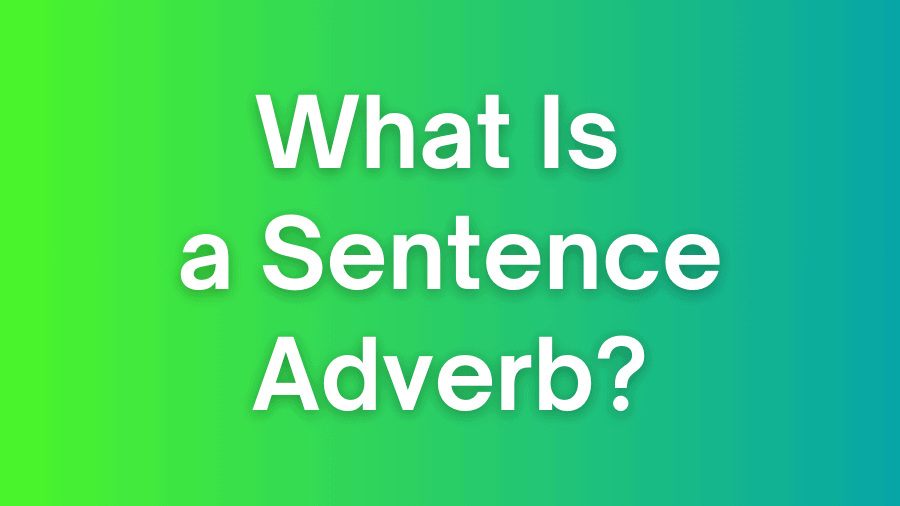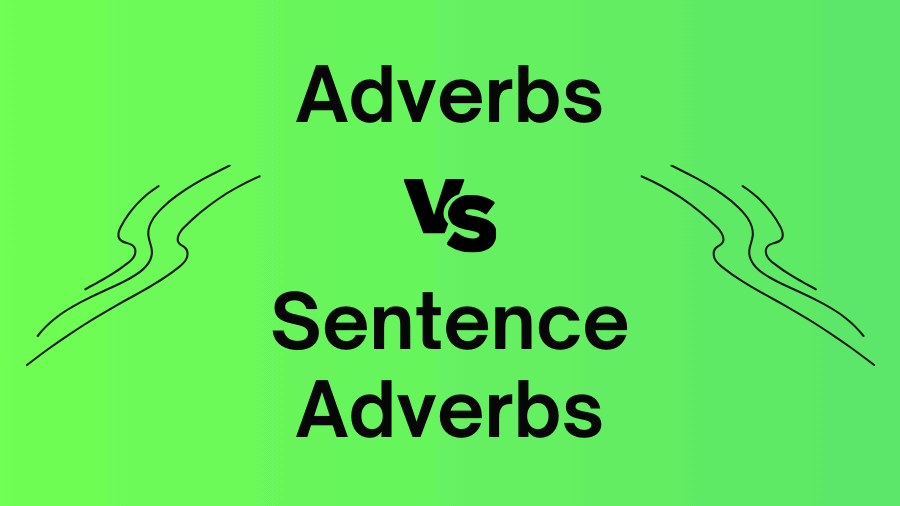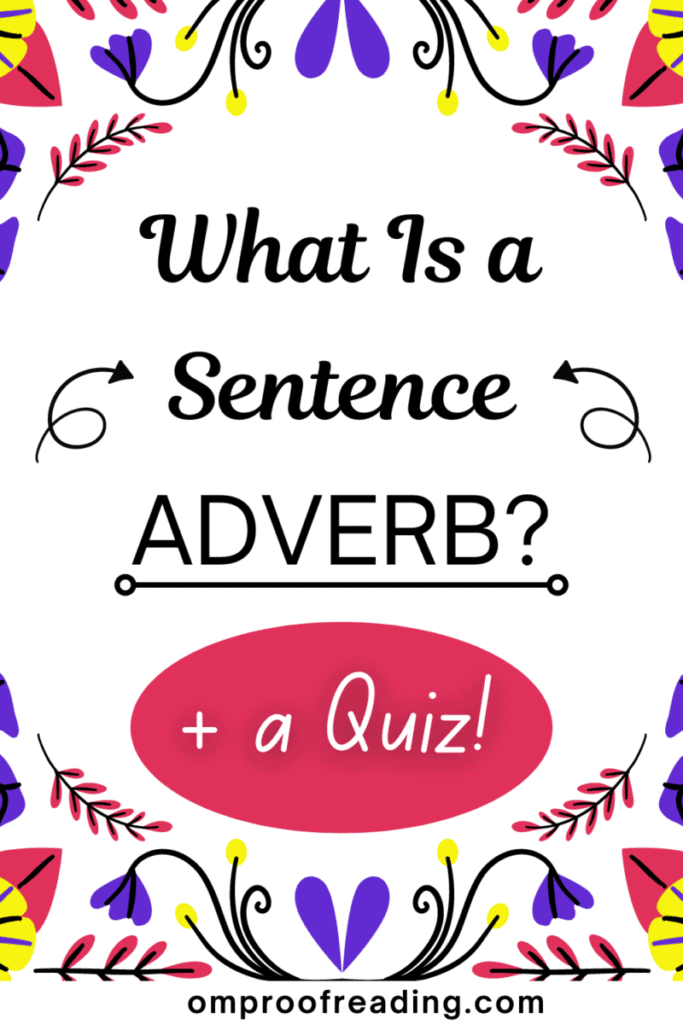This article may contain affiliate links. Please see our affiliate disclaimer in the footer menu for more information. Thank you for your support!

Although you’re probably somewhat familiar with adverbs, you may be unaware of sentence adverbs. As a trained proofreader who has studied the parts of speech, I can help you understand this unique kind of adverb.
Unlike other adverbs that modify a word or phrase, a sentence adverb modifies an entire sentence. It expresses the writer’s or speaker’s sentiment about the information conveyed in the sentence.
Let’s learn about the purpose and placement of sentence adverbs so you can identify them and use them successfully. We’ll also see this kind of adverb in action. Finally, you can check your understanding of what you’ve learned with a quiz.
What Is an Adverb?
Adverbs are one of the eight parts of speech in the English language.
They can modify (i.e., describe) three parts of speech: verbs, adjectives, and other adverbs.
When adverbs modify these parts of speech, they answer one of the following questions:
- How?
- When?
- Where?
- To what extent? (How often? or How much?)
And as we now know, adverbs can even modify complete sentences!
Om Proofreading has an article about identifying adverbs if you need help to master this part of speech.
What Is a Sentence Adverb?
A sentence adverb modifies the whole thought being expressed.
It describes the writer’s opinion, attitude, or feeling toward the sentence.
An Expert Definition
The Merriam-Webster.com Dictionary tells us that a sentence adverb is
“an adverb that limits or describes the meaning of an entire statement rather than just a single word or phrase.”
Source: Merriam-Webster.com Dictionary
As Merriam-Webster suggests, the defining feature of a sentence adverb is that it modifies the entire sentence, not just part of it.
The Purpose of These Adverbs
The Chicago Manual of Style (CMOS) helps us to further understand the purpose of this sort of adverb by stating the following:
“Sentence adverbs most commonly indicate doubt or emphasize a statement’s certainty. Some common examples are maybe, possibly, and however.”
Source: CMOS
Writers and speakers employ sentence adverbs to comment on the information expressed in a sentence.
Their Placement in Sentences
Although sentence adverbs frequently come at the beginning of a sentence, they can also appear in the middle or at the end (source).
Let’s look at an example of one in all three positions.
Luckily is our sentence adverb.
Let’s go!
Beginning: Luckily, she saw the rainbow.
Middle: She, luckily, saw the rainbow.
End: She saw the rainbow, luckily.
Adverbs vs. Sentence Adverbs

We have regular adverbs and sentence adverbs.
How do we differentiate between these two types of adverbs?
We ask ourselves whether the adverb modifies the whole sentence or just a word or phrase.
Let’s see sentences using the following adverbs: remarkably, happily, and surprisingly.
I’ll give you two sentences for each adverb.
The adverb will be used as a regular adverb in the first sentence and a sentence adverb in the second sentence.
Remember that adverbs can answer the question how about the verbs, adjectives, and adverbs they modify.
Example 1
1) Heath ran remarkably fast.
In this sentence, remarkably is modifying the adverb fast.
How fast did Heath run? (remarkably)
2) Remarkably, Heath wasn’t out of breath after running so fast.
Here, remarkably isn’t modifying one word or phrase. Instead, it’s expressing an opinion about the sentence as a whole.
The writer (that’s me, Lindsay 😊) thinks it’s remarkable that Heath didn’t huff and puff after running so hard.
Example 2
1) The child happily hopped from rock to rock.
Happily is modifying one word: the verb hopped.
How did the child hop? (happily)
2) Happily, the child didn’t fall while jumping from one rock to another.
Happily shows the writer’s feelings about what this sentence tells us. She’s happy the child didn’t fall while rock hopping.
Example 3
1) The boy slept surprisingly well.
Surprisingly modifies the adverb well.
How well did the boy sleep? (surprisingly)
2) Surprisingly, the boy slept well despite the noise.
Surprisingly demonstrates what the writer thinks about the boy sleeping well despite the noise. She’s surprised the boy could sleep so soundly with the ruckus!
A List of Sentence Adverbs
Here are 30 examples of sentence adverbs.
- accordingly
- apparently
- astonishingly
- certainly
- clearly
- fortunately
- frankly
- happily
- honestly
- hopefully
- however
- ideally
- indeed
- interestingly
- ironically
- luckily
- maybe
- naturally
- obviously
- perhaps
- possibly
- presumably
- regrettably
- sadly
- similarly
- surely
- surprisingly
- truthfully
- undoubtedly
- unfortunately
This type of adverb usually ends in ly.
Only four adverbs on the above list do not end in ly.
Example Sentences with Sentence Adverbs

Now let’s see these stellar adverbs in action!
- Apparently, they had been waiting for a while.
- Clearly Claire knows what she’s talking about.
- Generally, the meeting starts on time.
- We should, ideally, leave by nine o’clock.
- Luckily, the weather was nice enough for a hike.
- Obviously, they had played the game before.
- Perhaps it would help if Peter spent more time outside.
- Surely her dog wants to play a bit longer.
- The directions were easy to follow, fortunately.
- Undoubtedly, their diligent research will benefit humanity.
Frequently Asked Questions
How are sentence adverbs punctuated?
A comma often (but not always!) follows sentence adverbs that come at the beginning of a sentence.
Here are two examples from CMOS:
- “Fortunately, we’ve had rain this week.”
- “Undoubtedly he drove his car to the depot.”
Note: These two sentences come from the 17th edition of CMOS, section 5.157.
The first sentence contains a comma after the sentence adverb, but the second one doesn’t.
If you want to emphasize a sentence adverb, put a comma after it. The comma creates emphasis because it signals the reader to pause after reading the adverb.
Commas sometimes set off a sentence adverb in the middle of a sentence. A sentence adverb is more likely to be surrounded by commas if it contains nonessential information.
A comma typically precedes sentence adverbs at the end of a sentence. Placing one at the end of a sentence makes it feel more like an aside, so it usually merits a comma.
Can hopefully be used as a sentence adverb?
Yes, hopefully can be used as a sentence adverb; however, some people are opposed to it. I think the best defense for using hopefully to modify entire sentences is the following:
“Hopefully has been used as a sentence adverb since at least 1648. Hopefully, that’s good enough for you.”
Source: Merriam-Webster.com Dictionary
Indeed, those two sentences pack a powerful punch. 😉
Quiz: Sentence Adverbs
Now that you’re more sure about this genre of adverbs than ever before, let’s check your comprehension with a quiz.
You’ll get feedback for questions you get wrong.
Have fun!
Important: After you complete the quiz, please scroll back up the page to click the “View score” button.
Ideally, this article has helped you understand a special kind of adverb. Undoubtedly, you recognized that these last two sentences started with sentence adverbs. 😉
Best wishes to you!
“When you go out into the woods, and you look at trees, you see all these different trees. And some of them are bent, and some of them are straight, and some of them are evergreens, and some of them are whatever. And you look at the tree and you allow it. You see why it is the way it is. You sort of understand that it didn’t get enough light, and so it turned that way. And you don’t get all emotional about it. You just allow it. You appreciate the tree.
Ram Dass
The minute you get near humans, you lose all that. And you are constantly saying ‘You are too this, or I’m too this.’ That judgment mind comes in. And so I practice turning people into trees. Which means appreciating them just the way they are.”

Recent Posts
Punctuation is important because it enables us to communicate our message clearly and effectively. Without punctuation, we wouldn’t understand how units of a sentence relate to one another or how...
Punctuation mistakes are everywhere! The problem is that these errors can make you appear less credible or professional. Polished writing is a sign of someone who cares about their work and pays...
